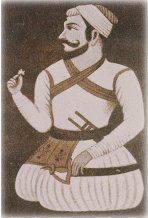Shahaaji was a great source of advice and comfort to Shivaji and his mother, Jijabai, in their efforts to create an independent nation. Shahaaji was aware that Moslem kings were able to rule primarily due to the
 loyalty
and bravery of many Marathi knights and soldiers in their employ. Nonetheless,
these kings still harassed their Hindu subjects in a variety of ways: destruction
of temples, forced conversion to Muslim religion, extra taxation (Jizia)
for their “fault” of being born a Hindu, abduction of Hindu womenfolk,
and so on. As has been mentioned earlier, there have been a number of documents
listing the auction prices for Hindu women depending on the fairness of
their skin, their social status prior to abduction, their age, etc. Being
disgusted with this treatment, Shahaaji attempted to create an independent
nation around his estate in today’s Pune district. Unfortunately, he tried
to “market” his vision among other knights – most of whom were selfish
as well as risk averse and preferred status quo.
Few other Marathi knights accepted his vision and
his first attempt at independence was a failure. Murar JagDev, an otherwise
quite honorable Hindu knight of Vijapur darbaar,
destroyed Shahaaji’s “kingdom.” In keeping with the superstition of that
period, Murar Jagdev plowed the farmland around Pune using donkeys instead
of bulls and dug stakes in the ground and hung old leather shoes from these.
This was his way of proclaiming that this land was not fit for farming!
loyalty
and bravery of many Marathi knights and soldiers in their employ. Nonetheless,
these kings still harassed their Hindu subjects in a variety of ways: destruction
of temples, forced conversion to Muslim religion, extra taxation (Jizia)
for their “fault” of being born a Hindu, abduction of Hindu womenfolk,
and so on. As has been mentioned earlier, there have been a number of documents
listing the auction prices for Hindu women depending on the fairness of
their skin, their social status prior to abduction, their age, etc. Being
disgusted with this treatment, Shahaaji attempted to create an independent
nation around his estate in today’s Pune district. Unfortunately, he tried
to “market” his vision among other knights – most of whom were selfish
as well as risk averse and preferred status quo.
Few other Marathi knights accepted his vision and
his first attempt at independence was a failure. Murar JagDev, an otherwise
quite honorable Hindu knight of Vijapur darbaar,
destroyed Shahaaji’s “kingdom.” In keeping with the superstition of that
period, Murar Jagdev plowed the farmland around Pune using donkeys instead
of bulls and dug stakes in the ground and hung old leather shoes from these.
This was his way of proclaiming that this land was not fit for farming!
Shahaaji then became a knight of ShahJahan and later of Daulatabad. When the king of Daulatabad died, Shahaaji installed the king’s young son as the next king and appointed himself as Vizier (chief consultant to the king). For all practical purposes, Shahaaji was the de facto ruler for a period of five years until the joint forces of Delhi and Vijapur destroyed that kingdom. Shahaaji became a knight of Vijapur darbaar. However, following the cautionary advise by King ShahJahan of Delhi, the king of Vijapur appointed him to Bangalore – hundreds of miles away from the forts of Deccan – an important source of Shahaaji’s (and later on, Shivaji’s) strength. In effect, Shahaaji was exiled to Bangalore. In today’s corporate terminology, he was “kicked upstairs
Shahaaji accepted his fate but supported Shivaji’s fledgling “nation” by sending his best talents to Pune for advising Shivaji in the ways of diplomacy. One of those advisors had the title of a Peshawaa (prime minister), a clear proof of his expectation that someday Shivaji would be a king. These advisors were responsible for many of the early victories of Shivaji and the acceptance of his rule in the 36-town estate in today’s Pune district. When Shivaji began capturing Vijapur forts around Pune and the King of Vijapur complained, Shahaaji declared that “My son does not obey me” and refused to participate in military campaigns against his “rebellious” son who was befriending “vagabond” boys – meaning boys who were not from the “noble” ninety-six families.
Shahaaji wanted to establish a similar kingdom in Southern India, and had groomed his other son, Sambhaji, for this role. Unfortunately, that vision remained a dream when Sambhaji, Shahaaji’s first son, was betrayed by AfzulKhan, a Vijapur Knight (officially a colleague of Shahaaji) during a battle, and suffered an untimely death. Nonetheless, Shahaaji’s diplomatic efforts in South India helped Shivaji in his later expedition to the South. The southern fort of Jinji was helpful to Rajaram, Shivaji’s second son, in his fight against Aurangajeb.
Shahaaji himself was captured through betrayal by AfzulKhan, but was released after a supremely successful diplomacy by Shivaji. Since then, Shahaaji effectively retired from active military duty and enjoyed a leisurely life in Bangalore. Nonetheless, he continued to advise his son till his untimely death from a hunting accident in 1664.
The now-famous Shivaji
Mudra (royal seal) was designed by Shahaaji when Shivaji was
only 14 and clearly shows Shahaji’s vision of his son’s future. Shivaji
fulfilled his parents’ dreams when he became the first Marathi king. ![]() Part 4
Part 4